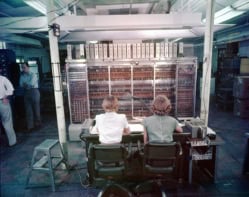Light is a Messenger: The Life and Science of William Lawrence Bragg
Graeme K Hunter
2004 Oxford University Press 322pp £35.00/$59.50hb

Sir Lawrence Bragg was my professor in my student and early teaching days. To his family he was Willie, and only became Sir Lawrence because his father was already Sir William. If I refer to him as Willie it is simply to avoid ambiguity; of course, I never thought of him or addressed him so. The two Braggs had shared the 1915 Nobel Prize for Physics for inventing X-ray crystallography; Willie, at 25, was the youngest winner ever. His pride, however, became tinged with regret since it was assumed too easily by others that his father was the originator who was generously recognizing help from his son.
In fact it was Willie – a research student at the time – who had the big idea about reflection from crystal planes, and who was later to show such skill in interpreting the diffraction patterns. Sir William’s principal contribution lay in instrument development. Theirs was a real collaboration, but not without tensions. We youngsters who knew him as Cavendish Professor in post-war Cambridge knew nothing of the bouts of depression, the sense of inadequacy and the rare but explosive angers of the suave and kindly Edwardian gentleman who had charge of our destinies.
Having become famous at the very outset of his career, Willie – who was then not yet 30 – succeeded Rutherford first at Manchester and then, 20 years later, at Cambridge. But unlike Rutherford, he had little knowledge of nuclear physics or a desire to learn more. Bragg had been a student long before the discovery of quantum mechanics, and was too busy to catch up following its appearance. So when Linus Pauling came on the scene as a very real rival in the 1950s, Bragg faced a skilled quantum theorist and unquestionably a greater chemist. We cannot be surprised to learn of a German scientist in the 1930s wondering “How does Bragg discover things? He doesn’t know anything”. The only possible answer is that he loved what he was doing, believed research was his most important task, and was prepared to spend all the time needed for his powerful and distinctive imagination to get to grips with a problem. As the Cambridge geophysicist Teddy Bullard once remarked, “Bragg can’t stand having anyone cleverer around, and it’s lucky for the Cavendish he’s so clever himself”.
With his limitations and hatred of administration, how well did he cope at the Cavendish Laboratory? In the vernacular of the time, jolly well. He had to reconstruct everything in 1945, with no hope of recovering the lab’s pre-eminence in nuclear physics but with a queue of talented wartime graduates longing to get their teeth into research. With Norman Feather’s aid, he took his pick and encouraged individual research groups to make their own way, breaking from the monolithic Rutherford tradition (which was not, in fact, quite so monolithic as legend has it).
From this initiative sprang conquests in radio astronomy, low-temperature physics, metal physics and, in due course, molecular biology – the finest Cavendish achievement of all. He also got the university’s agreement to appoint a laboratory secretary and an accountant so that in the end, and against the odds, he himself could find time for research – encouraging and inspiring Max Perutz and John Kendrew in their all-but-impossible ambition to resolve completely the structure of a protein.
“When I was stuck,” Perutz told me, “I’d talk to Bragg and he always had a suggestion for overcoming the difficulty.” From the few conversations that I had with Bragg at the time, I know this was true – the old buffer was not past it by a long chalk.
Bragg left the Cavendish in 1953 to become director of the Royal Institution (RI), just as his father had done in his time. His immediate predecessor, the spasmodically likeable Edward Andrade, had very nearly wrecked it. The story of his dismissal and of Bragg’s appointment is told in the book in some detail and is wryly amusing if one can forget the accompanying private agonies.
It was at the RI that Bragg fully developed Michael Faraday’s tradition of lectures “to a juvenile auditory”. He had never been wholly successful in lecturing to students but he threw himself into the task of making science exciting to schoolchildren and revealed an enviable gift for analogy and metaphor. He was, perhaps for the first time in his life, really happy while at the RI – having a duty that was a pleasure, a talented team of researchers, and a wife, Alice, who had always given him the love and support he needed. She had talents of her own, and a commanding but friendly presence that had earlier graced her stint as mayor of Cambridge. As a Justice of the Peace, she had expected students to set a good example; to one, charged with a cycling offence, the policeman on duty whispered, “You’re for it, my lad, Lady B’s on the bench”.
I have said little about the science, which is central to the book. The pioneering analysis of mineral structures by X-ray crystallography was a cerebral sport demanding severe concentration, trial and error, and the special genius that was Bragg’s. In this first-ever biography of Bragg, Graeme Hunter – a biochemist at the University of Western Ontario – has done his best to explain the science without a mathematical deluge. However, I fear that many readers – including those who are scientifically literate – will find the details heavy going, even if they will thoroughly enjoy the human story. Bragg himself might have done the trick, but it takes a certain familiarity with crystallography to follow the account with confidence.
All the same, the reticent academic gent was a very important creator, whose life story makes excellent reading.



